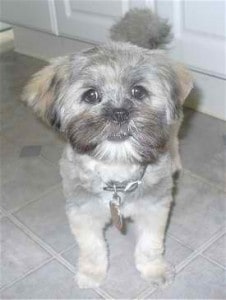Good day and welcome everyone!
This is Sharda with another Lhasa Apso Puppy newsletter.
When choosing a Lhasa Apso puppy it is important to make sure that the puppy or dog that you decide on is healthy.
There are some important observations that you can make prior to taking the animal home.
Most breeders, rescue centres or pet stores should offer some kind of written health guarantee, however, there are some other considerations you should take into account too.
KENNEL AND ENVIRONMENT CHECKS
Before purchasing a puppy or a dog, take time to look at the kennel or area where the animal has been kept. Check that:
- The area is clean and well maintained, with all fecal material or soiled bedding removed.
- There is fresh water and food available to the dogs or puppies (if appropriate).
- The other animals in the kennel or area appear to be healthy and energetic.
PUPPY CHECKS
After inspecting the area the dog or puppy was kept in, check that:
- The puppy or dog appears active and energetic. Remember that a mature Lhasa Apso will tend to be reserved around strangers, but still will be attentive and focused.
- The eyes are bright with no discharge. Occasionally there may be some tearing, but there should be no marked discharge from the eyes.
- There should likewise be no discharge from the nose or mouth. Check for discoloration of the hair around the nose or mouth that could indicate a history of discharge.
- The ears should be clean and free from wax build-up or foul smell.
- The gums should be pink, and not red or swollen looking. Sometimes when puppies are losing teeth there may be some redness, but the breeder should address this issue with you.
- A puppy should have a sweet smelling breath. A foul or bad smelling breath can indicate health concerns.
- The coat should be shiny and healthy looking, and the dog or puppy should not be scratching or biting at the coat.
- The skin under the coat should be clean, smooth, and free from dandruff, irritation or dry patches.
- The puppy or dog should have good eyesight and hearing. You can check this by making a sudden noise or movement, and noting if the dog or puppy pays attention.
In addition a Lhasa Apso puppy should be attentive, alert and friendly. It should not appear to be afraid of people or of other dogs, as this may make it difficult to socialize the puppy.
A puppy is naturally very curious, and will want to be held and petted. A puppy that is very quiet or resistant to being petted may have difficulty adjusting to a home environment, and may be more difficult to train.
Since it is difficult not to get caught up in wanting one particular puppy, it is important to be objective, as much as humanly possible, when picking the best puppy for you and your family.
The same is true if you are picking a mature Lhasa Apso dog. A Lhasa Apso in good health will have a life expectancy of 12 to 18 years, so it is important to make sure your new pet is in the best possible condition.
If you are concerned with any of the issues above, make sure you discuss your concerns with the lhasa apso breeder. Find out their returns policy and their health guarantee.
In addition, plan to get the puppy checked by a veterinarian at the earliest possible time. Most reputable breeders will be very open to this option, and appreciate the fact that you are concerned about the health of your new dog or puppy.
Lhasa Apsos have known health issues with renal dysplasia, hip dysplasia, skin, kidney and eye problems.
It is important to check the lineage of the parents through the breeder or through the national kennel club or registry organization, to make sure the line that your puppy or dog came from is free from hereditary disease problems.
I hope that you learned a lot from today’s Lhasa Apso Puppy newsletter
All the best and take care
Warmly,
Sharda Baker

